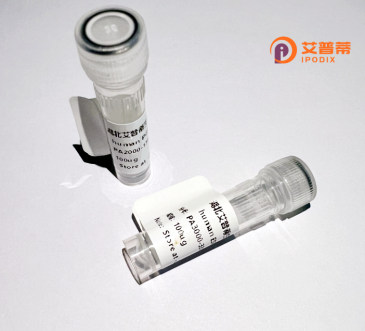
| 纯度 | >90%SDS-PAGE. |
| 种属 | Human |
| 靶点 | PPAP2A |
| Uniprot No | O14494 |
| 内毒素 | < 0.01EU/μg |
| 表达宿主 | E.coli |
| 表达区间 | 1-284 aa |
| 活性数据 | MFDKTRLPYVALDVLCVLLAGLPFAILTSRHTPFQRGVFCNDESIKYPYKEDTIPYALLGGIIIPFSIIVIILGETLSVYCNLLHSNSFIRNNYIATIYKAIGTFLFGAAASQSLTDIAKYSIGRLRPHFLDVCDPDWSKINCSDGYIEYYICRGNAERVKEGRLSFYSGHSSFSMYCMLFVALYLQARMKGDWARLLRPTLQFGLVAVSIYVGLSRVSDYKHHWSDVLTGLIQGALVAILVAVYVSDFFKERTSFKERKEEDSHTTLHETPTTGNHYPSNHQP |
| 分子量 | 56.98 kDa |
| 蛋白标签 | GST-tag at N-terminal |
| 缓冲液 | PBS, pH7.4, containing 0.01% SKL, 1mM DTT, 5% Trehalose and Proclin300. |
| 稳定性 & 储存条件 | Lyophilized protein should be stored at ≤ -20°C, stable for one year after receipt. Reconstituted protein solution can be stored at 2-8°C for 2-7 days. Aliquots of reconstituted samples are stable at ≤ -20°C for 3 months. |
| 复溶 | Always centrifuge tubes before opening.Do not mix by vortex or pipetting. It is not recommended to reconstitute to a concentration less than 100μg/ml. Dissolve the lyophilized protein in distilled water. Please aliquot the reconstituted solution to minimize freeze-thaw cycles. |
以下是关于重组人PPAP2A(LPP1)蛋白的3篇代表性文献简要总结:
1. **《LPP1水解细胞外溶血磷脂酸的活性研究》**
(Roberts et al., 1998)
研究团队首次证明重组人LPP1(PPAP2A)在细胞膜上表达时,能够水解细胞外溶血磷脂酸(LPA),揭示了其在调控LPA信号通路中的潜在作用。
2. **《LPP1通过催化溶血磷脂酸调节细胞迁移》》**
(Tanyi et al., 2003)
作者发现过表达重组LPP1可显著抑制癌细胞迁移,证明该酶通过降低胞外LPA浓度间接影响Rho信号通路,提示其在癌症转移中的抑制作用。
3. **《LPP1结构域功能及其底物特异性》**
(Jia et al., 2007)
该研究通过重组蛋白表达技术解析了LPP1的跨膜结构域和催化核心,发现其具有广谱磷脂磷酸酶活性,但对鞘氨醇-1-磷酸(S1P)亲和力较低。
Phosphatidic Acid Phosphatase Type 2A (PPAP2A), also known as LPP1 or Lipid Phosphate Phosphatase 1. is a membrane-associated enzyme belonging to the phosphatidate phosphatase family. It catalyzes the dephosphorylation of lipid phosphates, including lysophosphatidic acid (LPA), sphingosine-1-phosphate (S1P), and diacylglycerol pyrophosphate, generating bioactive lipid mediators that regulate cellular processes such as proliferation, migration, and survival. PPAP2A plays a critical role in lipid metabolism and signaling transduction by modulating extracellular concentrations of these signaling molecules, thereby maintaining lipid homeostasis and preventing excessive cellular responses.
This protein is integral to cardiovascular and immune functions, with studies implicating its activity in atherosclerosis, inflammation, and cancer progression. Its expression is tissue-specific, predominantly observed in the heart, skeletal muscle, and placenta. Dysregulation of PPAP2A has been linked to metabolic disorders, fibrosis, and impaired insulin sensitivity, highlighting its therapeutic potential.
Recombinant human PPAP2A protein is typically produced using expression systems like *E. coli* or mammalian cells, enabling structural and functional studies. Its recombinant form facilitates research into enzyme kinetics, substrate specificity, and inhibitor screening, advancing drug development for lipid-related diseases. The protein’s conserved catalytic domain and post-translational modifications make it a valuable tool for elucidating lipid signaling pathways and designing targeted therapies.
×